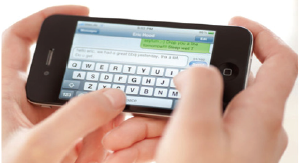UPE 2015

If you’re one of the 70% of cell-phone users who use text
messaging, you know that C U L8R means “See you later.”
“Texting” is now the new way to talk (or “tlk”), especially for
young people. But why is that?
IT’S A LOVE THING – There’s no doubt about it, text messages
are for personal communication. Only 10% of messages are
work related, and the peak hours for texting are between 10:30
and 11:00 at night!
Most users (64%) say texting is a good way to send romantic
messages – it’s easier to say “I love you” in a text message than in a phone call. Maybe that explains why
more people now use texting to send Valentine’s Day messages.
UPSIDES AND DOWNSIDES – Generally, texting is cheaper than making phone calls. It’s also more direct,
since you can send or get information without having to ask and answer polite “How are you?” questions.
And it’s more discreet, too. No one can hear your “conversations,” and you can receive text messages
almost anywhere – at work, in meetings, or in class. You can also use texting in noisy places like
nightclubs, where using a cell phone is difficult.
A NEW LANGUAGE? – Because it’s quicker to “write” without apostrophes and vowels, texting has its own
language. And it’s fun to use the symbols. There’s a best-selling dictionary (or “dxnre”) for texting called
Wan2tlk?
Some people say that a texting encourages bad punctuation and spelling. On the other hand, more teens
are writing than ever before. Now, that has to be a good thing.
(McCARTHY, M., McCARTEN, J. & SANDIFORD, H. Touchstone. Cambridge University Press. USA, 2005. Adaptado)
What do people use texting for?
Unfortunately, people use it just to have fun with friends.
They use texting to send messages to their bosses.
People text to solve problems at work regularly.
Most people use texting to cheat during a test at school.
Most people use it for personal communication. A few people use it for work.
E mais: nota TRI a todo o momento.





